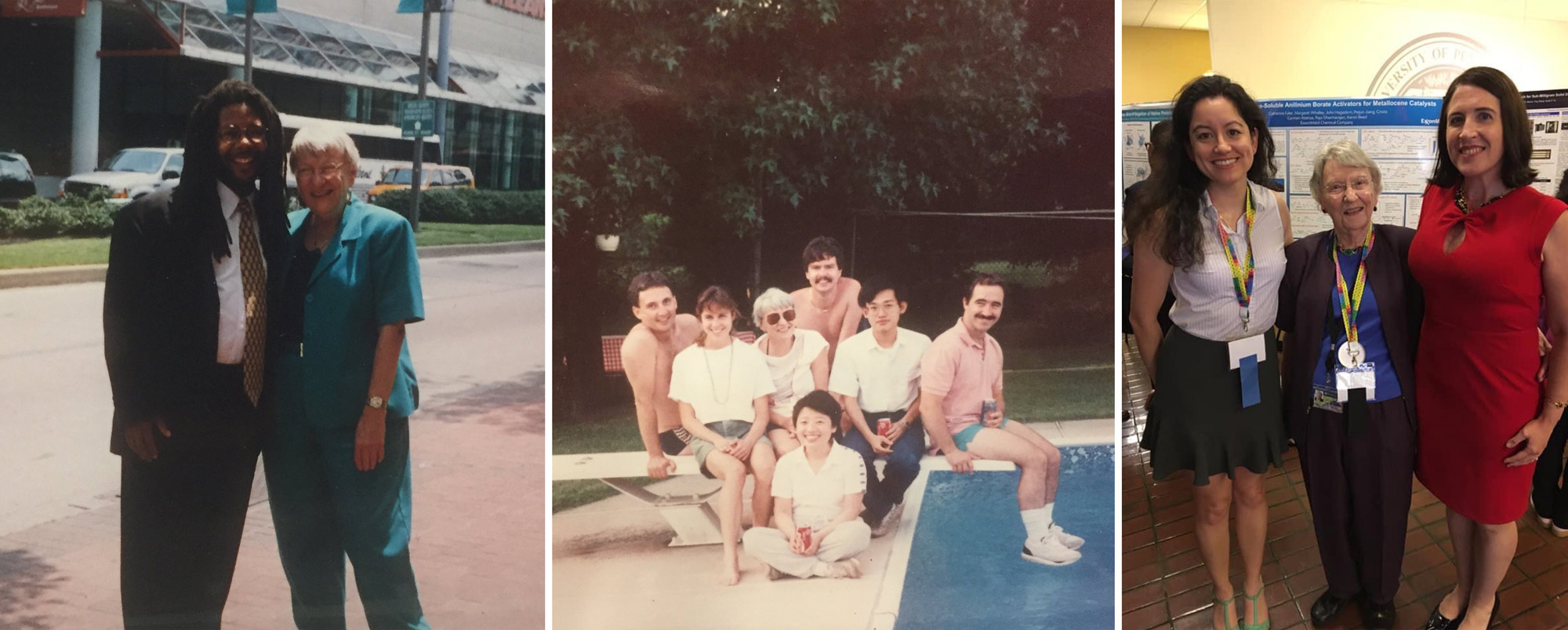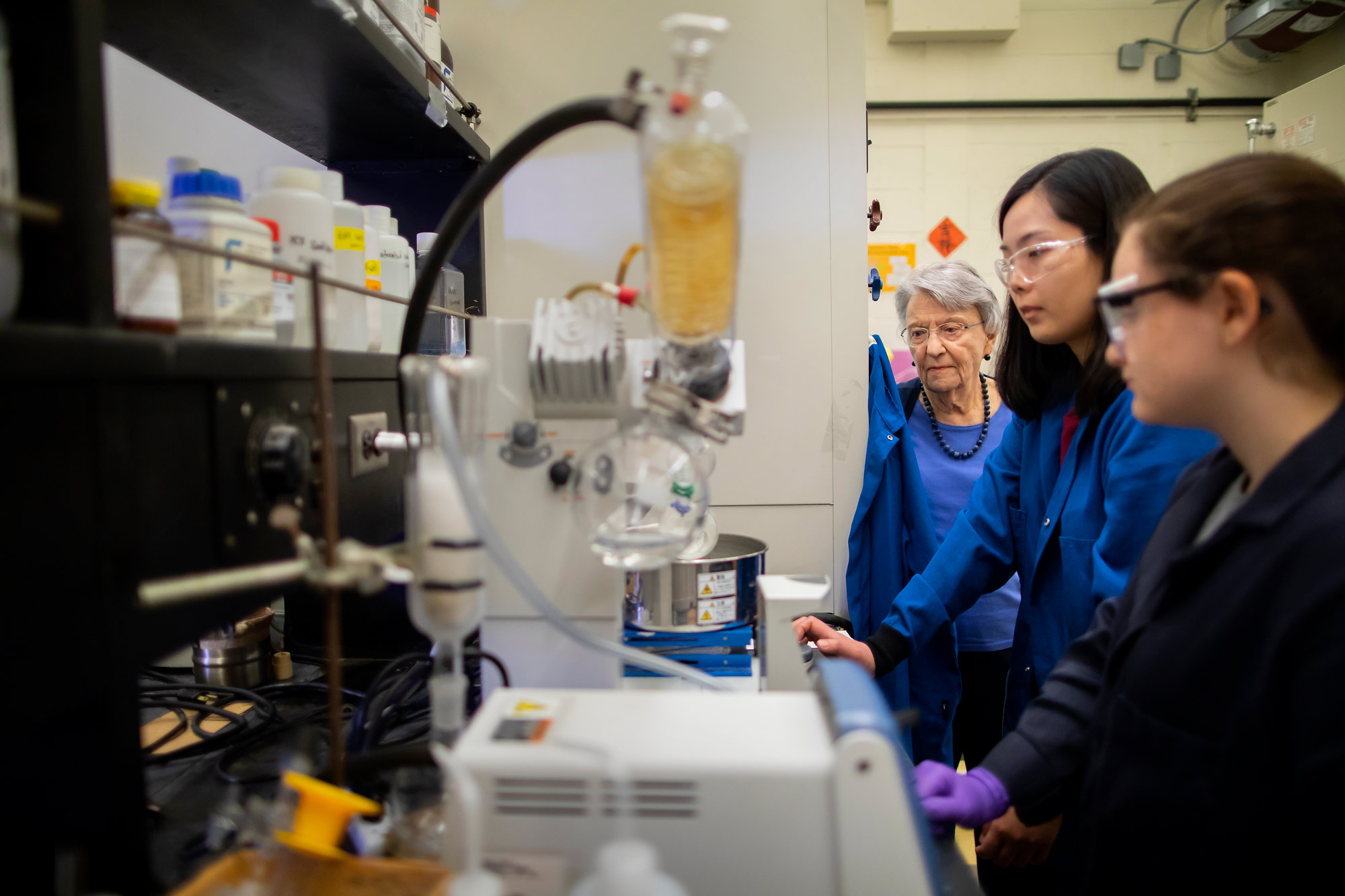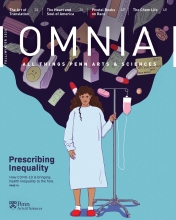Agent of Change
Madeleine Joullié makes molecules and waves, leaving her mark in her specialty, her institution, and the lives of her students.
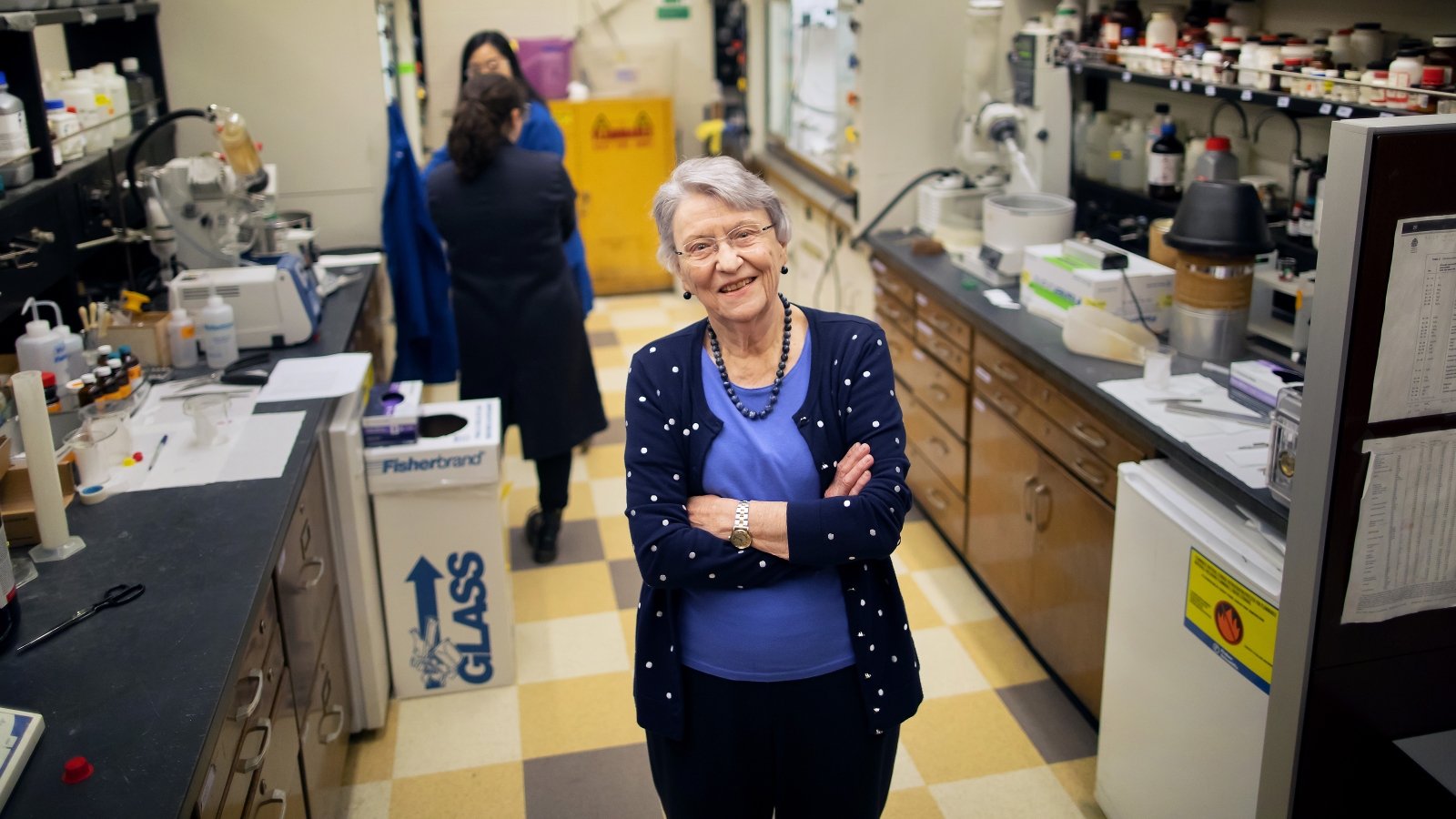
Editor’s Note: This story originally ran in 2020, but in celebration of Women’s History Month, we wanted to share it again.
Almost 90 years ago, Madeleine Joullié decided she wanted to be a chemist, and she hasn’t let up.
The professor of chemistry has authored or coauthored 300 papers and three textbooks (one in Portuguese), synthesized dozens of compounds used in medical treatments and fingerprint analysis, and received more than 30 honors and awards. She was the first female organic chemist to be appointed to a tenure-track position in a major American university. She became a member of the Board of Directors of the American Chemical Society, where she helped develop professional guidelines for chemists and pressed for equal opportunity. And there are the thousands of students, undergraduate and graduate, whom she’s mentored, and all they’ve done in turn.
The numbers are impressive, but they don’t give the full picture. “My favorite story about Madeleine is about one of her professorial colleagues swearing at her,” says David Christianson, Roy and Diana Vagelos Professor in Chemistry and Chemical Biology and Department Chair. “They were having an argument and bad words were used by the male colleague, and Madeleine said, ‘Don’t swear at me because I can swear right back at you in three different languages.’”
She demands much from herself and from those around her, and it has brought her respect and devotion. Christianson calls her a dear colleague and friend, and “one of the jewels in the crown of the Ivy League.” “I absolutely love her. I would do anything for her,” says former graduate advisee Catherine Faler, GR’07, a staff chemist at ExxonMobil Chemical. “She’s one of my favorite people in the world,” states James Tarver, GR’03, another Joullié alum, now Chief Research Administrator for the Department of Medicine at the University of Pennsylvania.
“It’s sort of a game.”
“I was always interested in chemistry,” says Joullié. “I wanted to know ‘What’s going to happen if I do that?’ I still find the same thing interesting. When I get up, I want to go do chemistry.”
Born in France and raised in Rio de Janeiro, Joullié attended Simmons College in Boston, then came to Penn in 1949, the only woman among the chemistry graduate students in a building that didn’t even have a women’s bathroom. But she’s not one to be deterred, and her curiosity is voracious. She looked at false smut disease on rice plants and saw opportunity. She’s investigated a fungus found in Roquefort cheese and had her undergraduates learn how to grow more of it. And she wants to know more about the chemistry going on in electronic cigarettes.
As a synthetic chemist, Joullié examines products and materials to learn what they do and how to make them artificially and create new structures. “The challenge of making new compounds was always very interesting to me,” she says. “You wonder, what are these compounds doing? Why are they there and what is their function? I think there’s no end to what you can do.”
When I get up, I want to go do chemistry.
“It’s sort of a game, how you go about it,” she continues. “Some things work, some simple reactions that should work sometimes refuse to work. In chemistry you are going to find more failures than success. I’m basically an optimist. If everything was too easy, it would be boring.”
In the early 1970s Joullié successfully synthesized tilorone, which helps protect cells and is used as an antiviral drug, work that earned her the 1972 ACS Philadelphia Section Award. In 1980 she was the first to report an asymmetric total synthesis of the antibiotic (+)-furanomycin and the first to use a particular type of chemical reaction to synthesize an artificial amino acid. She helped develop methods for aromatic substitution, in which a chemical bond is broken and replaced, and introduced the term “chirality transfer,” the transfer of properties through a chemical bond.
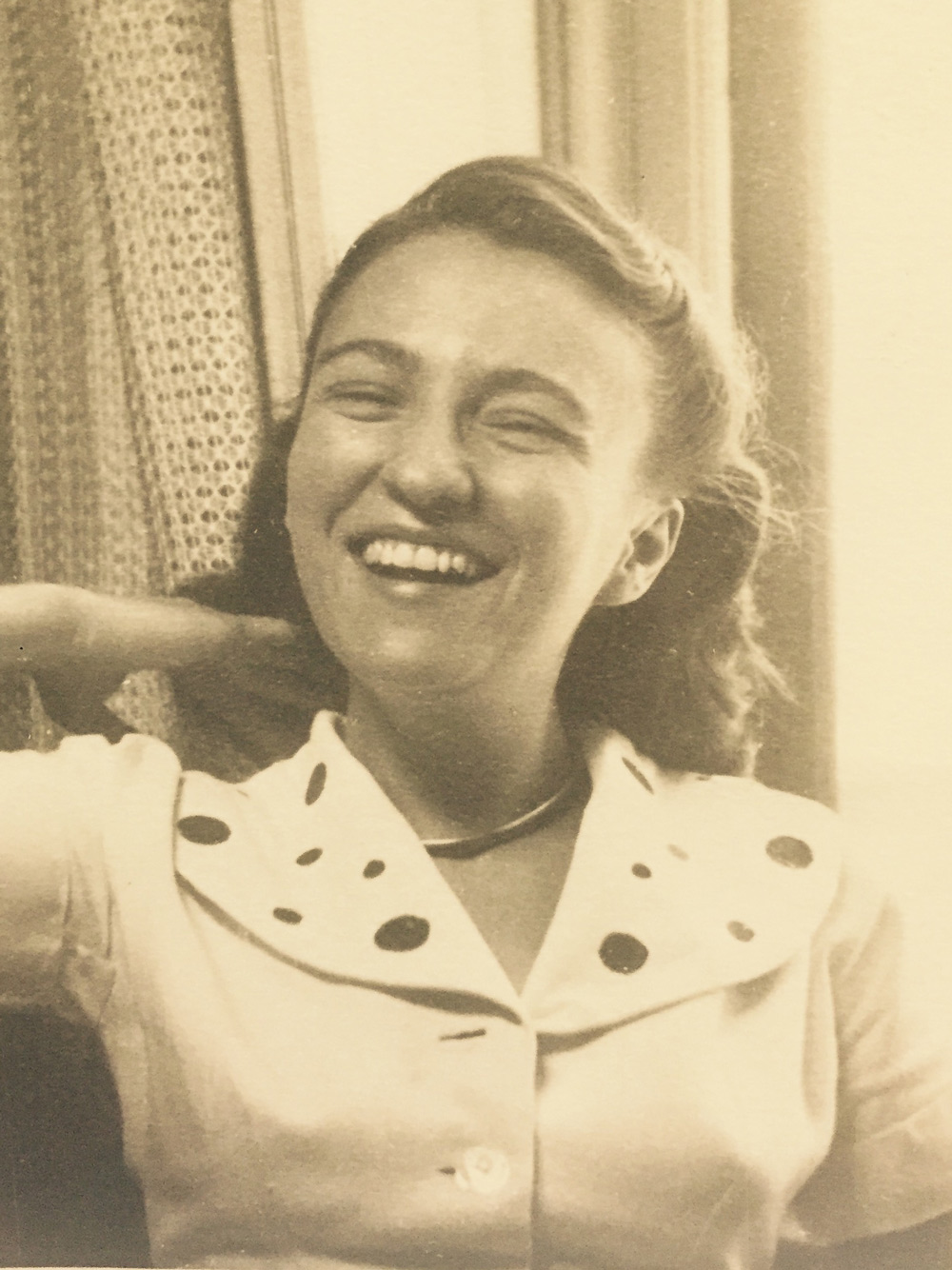
Madeleine Joullié, Professor of Chemistry, in 1949
Courtesy of Madeleine Joullié
In the late ‘80s, Joullié worked with Judah Folkman of Harvard Medical School and Paul B. Weisz in Penn Engineering to help synthesize beta-cyclodextrin sulfate, a sugar molecule that attaches to the walls of growing blood vessels and decreases the growth of new capillaries. This can cut the blood supply to malignant tumors and restrict their growth. Her compounds made Folkman’s treatments 100 to 1,000 times more potent, and also helps limit restenosis—the growth of cells on artery walls that can lead to blockages at the site of surgical procedures.
She then turned her gaze on sea squirts, or tunicates, marine invertebrate animals, and investigated a chemical they use to protect their larvae. Her total synthesis of didemnin B in 1990 was a landmark event that led to fundamental contributions to understanding the chemistry and biology of this class of natural products. It became the first marine product to enter clinical trials addressing cancer, and has led to compounds with antitumor, antiviral, and immunosuppressive activities.
Then there was the day in the mid-’90s when the Secret Service made a surprise visit to her office. The agency asked Joullié to find a better way of developing fingerprints at crime scenes. Her lab identified a compound that is less damaging to evidence and more sensitive for law enforcement agencies.
“So you never know, chemistry can be applied to anything, and sometimes I think chemists do a disservice to themselves by just trying to focus in certain areas,” she says. “I think people have preconceived ideas of what research is going to be important and what research is not.” For this reason, Joullié would like to see scientists have more freedom to pursue promising new things. But, she says, “Science is overloaded with bureaucracy.”
Passion and Roadblocks
Joullié is an elected member of the American Academy of Arts and Sciences and a fellow of the Royal Chemistry Society, and was a member of the editorial board for Chemical and Engineering News. The ACS has also given her its Garvan Award, Henry Hill Award, ACS Award for Encouraging Women into Careers in the Chemical Sciences, and the A.C. Cope Senior Scholar Award. She’s received the Lindback Award for Distinguished Teaching, Penn’s highest teaching honor, and has held lectureships around the country. In 2015 she received the John Scott Medal and Prize from the City of Philadelphia for her research work.
It’s a record that refutes the disrespect she received from some of her professors and classmates in graduate school. Her fellow students used to tell her that certain professors would “never give a girl an A,” she remembers. “I don’t know if they were right on this. I didn’t get an A, but that’s okay. I wasn’t that concerned about grades.”
Joullié says she was there to do work and that’s all she cared about. “Whatever people used to say, I just would dismiss it and forget about it.” Once they realized how good her class notes were, though, some of the male students did start to borrow them.
After she earned her Ph.D., Joullié was turned down for a job at DuPont, which didn’t hire women scientists at the time. Instead, she became the first woman to teach in Penn’s chemistry department. No graduate students would work with her, so she conducted research with undergraduates for years. When she finally got graduate students, they were women. “It took me a while to get male graduate students,” she says, and adds, “I don’t pay much attention to the gender of the students. I think that everybody is a different human being.”
“I think her sense of humor has allowed her to survive all the challenges,” says Tarver, her former student. “She’s extremely resilient. She doesn’t wear it, but she is happy to share when there were situations that were challenging in her career and how she managed to overcome them.”
In the 1970s, Joullié was made Penn’s first affirmative action officer, which she considers the best thing, besides chemistry, she’s done in her life—though she says it made her the most unpopular person on campus for seven years.
“It wasn’t easy. It was totally a man’s world,” she reflects. “It took a lot of persuasion. I know that changing things is not that easy and it’s a slow process, but you can do it. I think today people are also starting to change things, and I can see the same things happening.” She has remained a proactive advocate of equal opportunity at Penn and in the larger world of chemistry.

Madeleine Joullié, Professor of Chemistry, with James Robinson, Director of the University’s Office of Equal Opportunity, in September 1979.
“We have more female faculty members in our department than any of our Ivy League peers,” says Christianson. “It’s because of the culture that Madeleine helped nucleate.”
If everything was too easy, it would be boring.
When asked what Joullié means to her as a female scientist, Faler says, “One of the things that irks me, as a woman in the sciences, is that usually our gender speaks louder than our accomplishments. But it is incredibly relevant because even today, women face a lot of barriers. And she faced so many more. But it annoys me how relevant it is.”
Faler continues, “I look at her as another woman who is an amazing chemist, and it doesn’t matter that she’s a woman. I also like to point out that she’s a great role model for men as well. All of my chemical brothers have also looked up to her and then they go out in the world and are also champions for women in science.”
An Indelible Mark
As a young scientist, Joullié was so focused on research that she wasn’t interested in teaching. Her advisor Allan Day persuaded her to try. Now she’s taught so many pre-med students that she can’t go to the hospital without running into one, and she’s still contributing to discussions about curriculum changes.
Joullié would tell her students she was training them for the real world and the real world was going to be hard on them, so she would be as well. She asked them to do better every day. Faler, who still calls Joullié “Boss,” says, “Best compliment she ever gave me was, ‘You are no worse than anyone else.’”
“Madeleine, for me, was sort of a breath of fresh air,” says Tarver. “She was one of the most well-read faculty members in the department, just in terms of awareness and exposure to science. It was great, because I found myself with lots of ideas, and she was a wealth of knowledge.”
He says she also gave her graduate students a lot of freedom to follow their own interests and ideas. “In some cases, it allowed people to spin their wheels a little bit, but they found their way out of it, and gained a reliance on their peers as well as their own ingenuity to drive things forward.”
Joullié fostered her students’ overall professional development, too, asking them to write grants and papers and give polished presentations. “No one’s going to care what you’ve discovered or what you made if you can’t communicate it and communicate it well,” says Faler. Joullié would also make sure her students got to professional conferences to present their research, sponsoring them herself.
Joullié feels she had good teachers and an inspirational advisor, but no real role models in her own youth, and has determined to be one. Faler says she set an example for others with her work ethic, her availability, and her service to the chemical community.
“I am a Joullié chemist and I have a reputation to uphold,” says Faler. “I still feel the responsibility to make her proud of me and to do good.”
“Across generations, Madeleine has made an indelible mark on students, trainees, and faculty,” says Tarver. “Her influence in my life reinforced these core values: respect for ideas and the people who generated them, requirement for adaptation and continuous growth, excellence as the minimum acceptable standard, and the need for diversity of thought and approach.”
Though she’s no longer teaching, Joullié continues doing research at 93. She sees fewer distinctions now between different types of chemistry, saying, “In the old days we had analytical chemistry, biochemistry, organic chemistry and we have now computer chemistry. But I think today you need all of these to solve problems.”
“I have seen the beginning of chemistry pretty much, in a way,” she reflects. “We’ve come a long way. The way things are done changes every day. I think that’s what’s important, to be able to understand the changes and go with them.”
